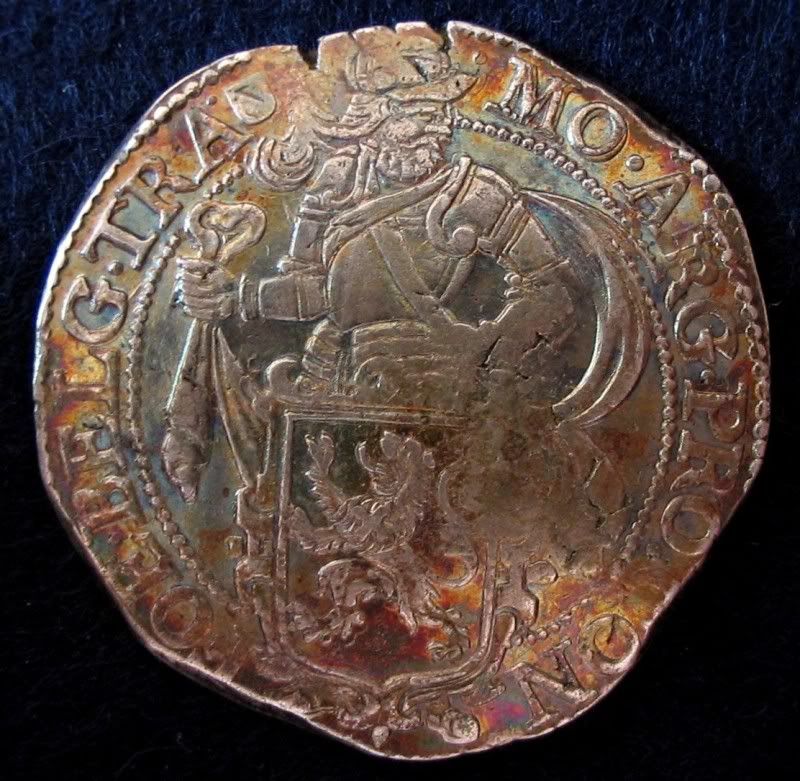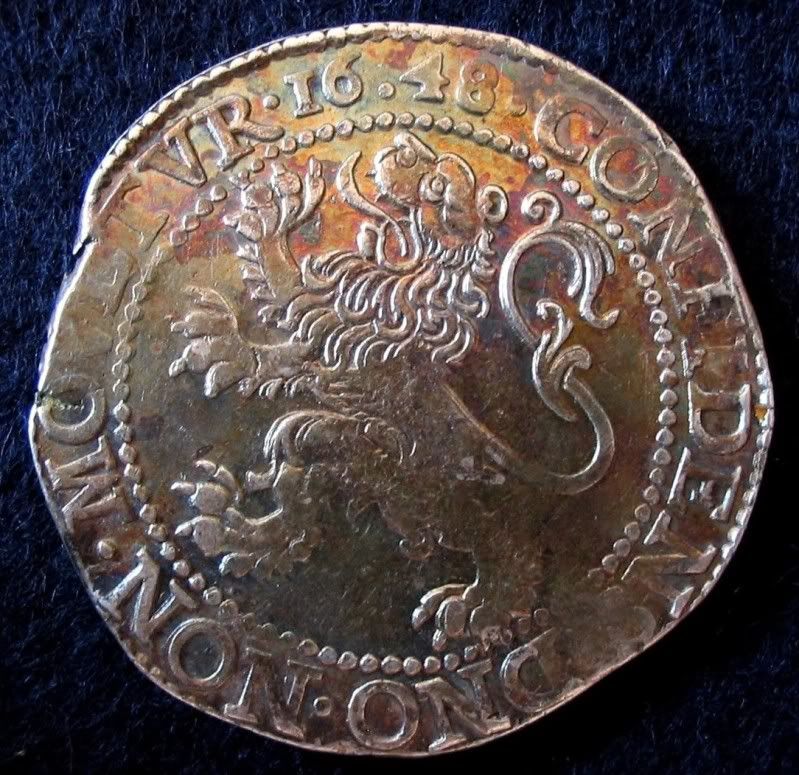multicolour dutch Liondaalder
Sometimes hopping over from the currencyforum, and looking at those beautifull coins on this forum,
I see a lot of multi colour coins overhere, and recently bought this dutch Liondaalder with the same
colours.
------Is this a natural proces ? I don't see any of these colored coins on dutch sites.
Liondaalder - silver 750/1000 - 27,7 gram - diameter 42mm - first type of coin issued by the United Netherlands during the separation of the Spanish empire.
 [/URL]
[/URL]
 [/URL]
[/URL]
I see a lot of multi colour coins overhere, and recently bought this dutch Liondaalder with the same
colours.
------Is this a natural proces ? I don't see any of these colored coins on dutch sites.
Liondaalder - silver 750/1000 - 27,7 gram - diameter 42mm - first type of coin issued by the United Netherlands during the separation of the Spanish empire.
 [/URL]
[/URL] [/URL]
[/URL] collector of Greek banknotes - most beautifull world banknotes - Greek & Roman ancient coins.
0
Comments
Impurities in the coin metal, outside environment, interior environment i.e. methods of storage (paper, wood) all will influence how slowly or quickly
or colorfully a silver coin will tone.
I'm not sure most Europeans like toned coins so they may dip them as a matter of course and I'm sure most coins over 100-200 years old have been cleaned once or twice or more. Cleaned coins will retone over time, some with very pretty colors, especially if they've been stored in certain high sulfer content albums.
Some older coins may have never been cleaned and added subtle coloration each year over a many decades long process. Morgan dollars have unique toning characteristics as do some Canadian series that are notorious for their ability to rainbow tone.
I love your example-age and history, colors and doubling, what's not to like?.
is that you end up being governed by inferiors. – Plato
very likely this coin was cleaned (dipped) some time ago, all the other lion daalders I own are grey /black
and yes, I agree it looks rather nice in its current state.
this coin was struck in 1648 , that year the war with Spain ended and the Netherlands were recognized by Spain as an independent
country. (Peace treaty of Münster) the war between Spain and the Netherlands lasted for 80 years (1568-1648)
Something doesn't look right to me on this coin
I looked it up in my Delmonte reference book Le Benelux D'Argent (Delmonte is one of the most respected reference books on Netherland (Lowland) coins).
The coin it is similar to is the Utrecht Ecu au Lion (Leeuwendaalder) Delmonte #845. It is of the highest rarity according to his scale - R.4.
What troubles me is the diameter of yours is 42mm but it references it at 40 mm (measured off of plate).
I have quite a bit of reference works to review before I can complete my analysis and I should get it done by later tonight.
Maybe my intial skeptism is wrong
in my dutch Passon catalog, # 2.28.53 the price range is 150 Euros in Very Fine and 250 Euros in XF
this catalog doesn't mention rarity scales.
Delmonte 845- KM32- Verkade 108.1
I noticed a similar coin sold for $3800 in XF in an Ira Goldberg auction
not shure what to make of that.
since I own a dozen (all different) of these Leeuwendaalders, I'm pretty shure its real.
would be a big surprize if it indeed rates R-4 , I only paid 80 Euros for it , bought on a local dutch site.
]
FOR SALE Items
these Lion daalders with a silvervalue of 29 stuivers (nickels) in 1575 were issued for 32 stuivers, the difference, 3 stuivers tax was used to finance
the war against Spain,
when silver prices soar, the value of this coin reached 40 stuivers in later years.
Here are some Lion coins from the shipwrecked VOC ship Campen , it went down in 1627, on her maiden voyage to Batavia.
In a storm, it hit the needles of the Isle of Wight - England.
cargo contained the usually spanish silver cobs and thousands of Lion daalders, struck in all the different dutch provinces.
most of the cargo was recovered in 1979.
the coin in the middle is encapsuled in a little carton booklet, with info about the VOC ship Campen.
900 booklets were sold in 1995 for 125 Euros a piece.
Yes, it is highly likely that it was cleaned, but such is the case with most of them that were dug or sea-salvaged, so who cares? The toning is probably longterm secondary toning that resulted after the cleaning, and I think it's nice, if not "100% natural". It's "market acceptable", as far as I'm concerned. (Better than that, actually.)
the multi colour was not dug or sea salvaged as far as I know, the year and type doesn't correspond
with any VOC ship that went down.
and as such, it doesn't fit in my main collection of shipwreck coins.
but since everybody likes it overhere, I also start to like it, more then before anyway,
and if silvereagle can confirm its an R-4 , I'll be over the moon.
<< <i>the year and type doesn't correspond with any VOC ship that went down. >>
Oh, but surely these were carried on more than just the VOC ships. Just like the Spanish pieces of eight, they were a pretty widespread trade coinage, and there is no telling how many unknown and undocumented shipwrecks are out there.
You're right, though- it doesn't look sea salvaged to me. Lightly cleaned long ago, perhaps, or maybe just stored in a sulfur-rich environment like an old bookshelf album.
You should like it, even if it doesn't fit in precisely with your shipwreck themed collection.
1st ... I have rechecked Delmonte and have concluded that it is #845, but the 1648 is not a rated rarity; therefore common (in a relative since) . Sorry for the news.
2nd .... My concerns were in the quality of the planchet (the numerous defects almost like casting voids) and like I said the date numerals don't look like the plate in delmonte. The problem is the plate is for #843, 1606-1634, so it may have changed a little in the later years.
Anyway it is a very unique coin with a great history. Own it proudly !!
Love your World Gold coin collection, especially the Netherlands department
Marco,
I have to limit myself to coins that came from wrecked VOC ships.
the VOC had a well documented administration that still exists today.
every ship that went down is accounted for, and although the location of these sunken ships is often
roughly known, its very difficult to locate them exactly nowadays.
the dutch government, who is the successor of the VOC , shows little interest to recover the lost cargos of
""their"" ships.
The last important recovery was that of the Flying Deer (Vliegend Hart) in 1983, it went down in 1735 near the shore of Zeeland,
Rex Cowan and John Rose , 2 Englishmen managed to salvage almost the complete cargo of that ship.
many coins were still in their original wooden cases.
the sister ship the Anna Catharina that went down on roughly the same position is still there on the bottum of the sea.